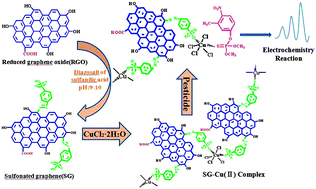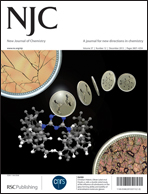A nanocomposite of copper(ii) functionalized graphene and application for sensing sulfurated organophosphorus pesticides†
Abstract
Reduced graphene oxide is modified with sulfanilic acid diazonium salt followed by copper(II) chelating to form a Cu complex nanocomposite. Characterization by Raman spectroscopy, FTIR and EDS, XPS, cyclic voltammetry demonstrates the successful functionalization of the graphene surfaces. Electrodes that are prepared by drop-casting the suspended nanocomposite solution on interdigitated electrodes (IDE) are tested for a novel pulsed amperometric detection of a series of sulfurated organophosphorus (SOP) pesticides, parathion, fenitrothion and malathion. A linear relationship of the pulsed amperometric current to the logarithmic value of concentration of the three SOPs is demonstrated with a R2 value of ∼0.95 at the S-OP concentration range of 1 ppb to 104 ppb. Negligible amperometric currents are observed in the control experiments using diethyl ethylphosphonate (DEEP) and dimethyl methyl phosphonate (DMMP), or S2−, SO32−, SO42− ions, suggesting sensing specificity to sulfurated compounds.


 Please wait while we load your content...
Please wait while we load your content...